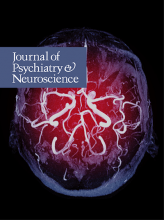A 57-year-old man with major depressive disorder presented with a 3-day history of psychomotor retardation, mutism and posturing. His symptoms had been well controlled with escitalopram. Chart review revealed 7 similar episodes in the previous 3 years, thought to be brief exacerbations of depression. Although they resolved spontaneously after a few days, the episodes had gradually worsened in frequency and severity. At the time of presentation, he had had 3 episodes in the previous 6 weeks. His initial Bush–Francis Catatonia Rating Scale1 (BFCRS) score was 22. Periodic catatonia (PC) was diagnosed and he was admitted for further evaluation and treatment. His MRI scan, basic laboratory values, thyroid stimulating hormone level and toxicology values were unremarkable. Intravenous lorazepam (8 mg/d) resolved symptoms completely within 24 hours. He was discharged, but was readmitted 2 weeks later with recurrent symptoms. This time lorazepam improved symptoms only moderately for 48 hours. It was discontinued in favour of amantadine (200 mg/d), which improved symptoms. He was continued on amantadine and the previous escitalopram dosage. He experienced no recurrence in the 6 months since; his most recent BFCRS score was 0.
Catatonia is a syndrome characterized by a constellation of affective, behavioural and motor symptoms. Clinical features include immobility, waxy flexibility, mutism, posturing, stereotypy, echopraxia, negativism and peculiarities of voluntary movement.2,3 Some patients manifest a hyperkinetic form with purposeless hyperactivity. Malignant catatonia is accompanied by autonomic instability and hyperthermia and is an emergent, potentially fatal condition.3,4 While catatonia was traditionally considered a variant of schizophrenia, the modern view is that its differential diagnosis is broad, representing a final common pathway of several psychiatric, neurologic and medical disorders.3
Catatonia generally has an insidious onset and progressive course. A rare and usually misdiagnosed form of catatonia, PC involves rapid-onset, brief, recurrent episodes of hypokinetic or hyperkinetic catatonia.5,6 These episodes can last 4–10 days and recur over a period of weeks to years. Patients are generally asymptomatic between episodes,5,6 although some authors have reported interepisode symptoms late in the course of illness.5–7 Also PC may have a better prognosis than other forms of catatonia.7 The pathophysiology of PC is less clear than that of catatonia in general. Older notions included cyclic shifts in nitrogen balance or thyroid function.5 There is evidence of autosomal dominant transmission of PC,8,9 but not of other forms of catatonia.8
Owing to the heterogeneous nature of catatonic symptoms coupled with the prolonged symptom-free intervals,6 PC is difficult to diagnose. Several scales can be used to identify catatonia and monitor treatment; the BFCRS is probably the easiest and most useful.1 The hallmark of PC is a history of recurrent brief episodes separated by periods of complete or near-complete remission. It is an urgent condition, generally requiring hospitalization for evaluation and treatment. Differential diagnoses include functional psychiatric illness, intoxications, metabolic encephalopathy, lupus, HIV, central nervous system infections, seizures, stroke, multiple sclerosis, neuroleptic malignant syndrome and serotonin syndrome.3,10
The evidence base for treatment of PC is anecdotal or limited to case reports. Most authors recommend pursuing similar treatment as for catatonia in general.6 Medium- to high-dose oral or parenteral benzodiazepines are considered first-line treatment, regardless of etiology, with response rates of 60%–80%.3,10 This response may be definitive or only short-lived.11 Benzodiazepines may also be helpful as a diagnostic probe; a rapid improvement may help confirm catatonia.10
If symptoms do not respond substantially or persistently to benzodiazepines, electroconvulsive therapy is reasonable.2–4,6,10 It is the most effective treatment for all forms of catatonia, both hypokinetic and hyperkinetic, and is also appropriate as first-line therapy when there is urgency to treat or for malignant catatonia.3,11 Atypical antipsychotics are sometimes effective for catatonia12,13 but should be used with caution; catatonia is a risk factor for neuroleptic malignant syndrome.3,11,12,14 Reports also suggest the use of N-methyl-d-aspartate receptor antagonists (amantadine, memantine) for catatonia.11,15 Finally, older case reports have suggested the use of lithium, specifically for PC, to prevent recurrent episodes or at least prolong interepisode intervals.6,16–18
Footnotes
The information in this column is not intended as a definitive treatment strategy but as a suggested approach for clinicians treating patients with similar histories. Individual cases may vary and should be evaluated carefully before treatment is provided. The patient described in this column is a composite with characteristics of several real patients.
Psychopharmacology for the Clinician columns are usually based on a case report that illustrates a point of interest in clinical psychopharmacology. They are about 650 words long. Columns can include a bibliography which will be available only on the journal website.
Competing interests: None declared.









